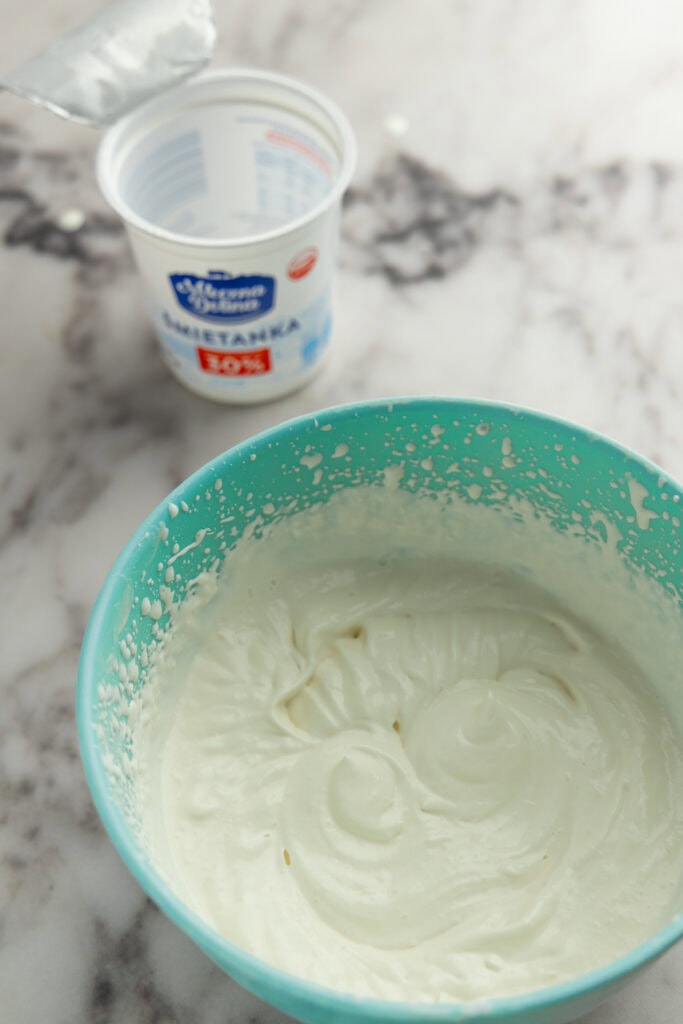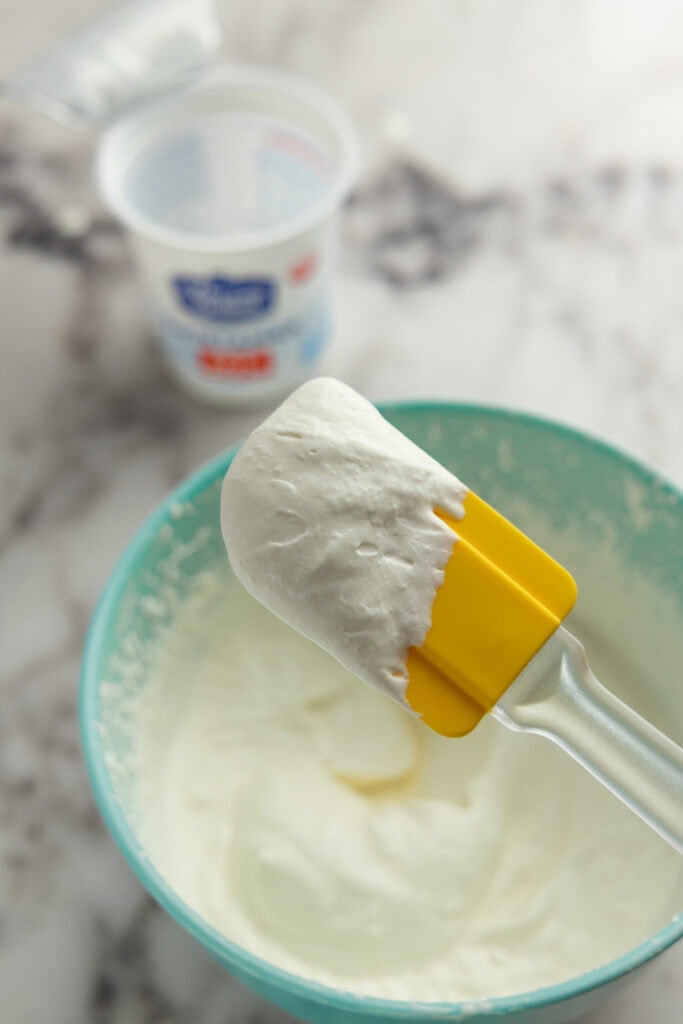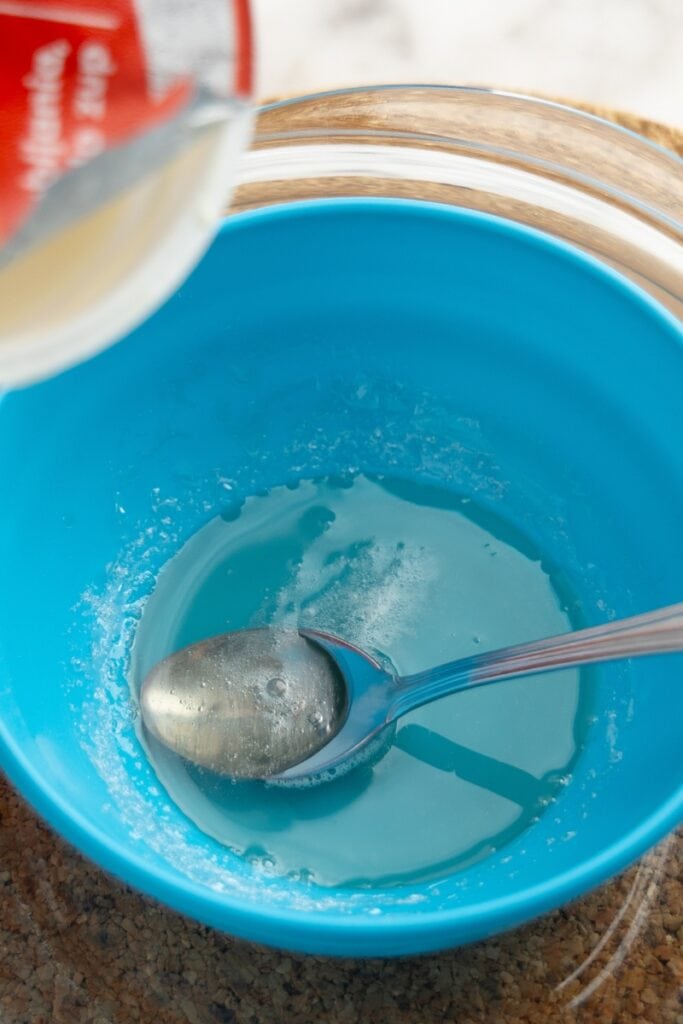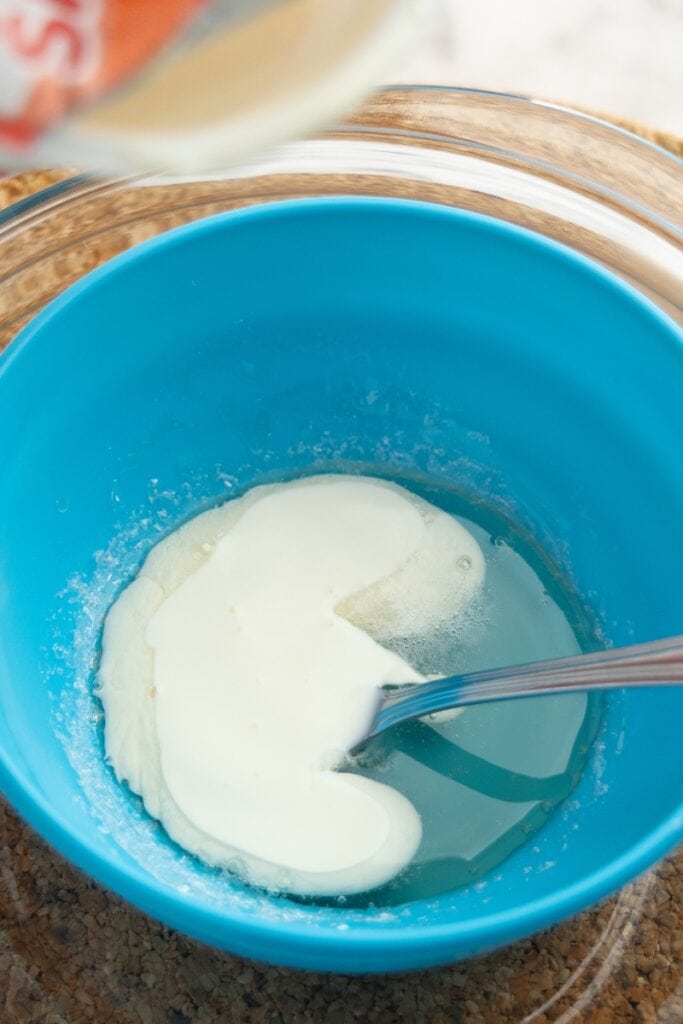Whipped Cream 101: Basics, Stabilization, and Infusions
This post may contain affiliate links. Read our privacy policy.
Ever wanted to whip up perfect whipped cream at home? Check out our guide that covers everything from the basics to some cool flavor hacks.

In this comprehensive guide, we’ll cover everything you need to know about whipped cream. We’ll start with the basics, like the importance of cold temperatures, then move on to a simple recipe and show you how to stabilize it using gelatin. Finally, we’ll dive into flavoring and infusions.
Curious about a specific topic? Use these jump links:
Before You Whip
Make sure your heavy cream, bowl, and beaters are well chilled before you start. This is crucial because cold temperatures are essential for the cream to incorporate air and whip properly.
Follow these practices for successful whipping every time:
- Chill Your Bowl and Cream. Pour the cream into the bowl you’ll use for whipping and refrigerate it for at least 30 minutes beforehand. That helps chill the bowl faster and gets it to the ideal temperature. Alternatively, if you have space, you can freeze the bowl for 15 minutes while leaving the heavy cream in its container.
- Freeze Your Beaters. Place the beaters in the freezer for 15 to 30 minutes before you begin. This ensures they are sufficiently cold to speed up the whipping process.
- Use a Metal or Glass Bowl. Metal and glass bowls are better at retaining cold temperatures than plastic ones, keeping everything cooler longer. That makes them better for whipping. However, I often use a tall, narrow plastic bowl, which works fine. Try out different bowls to see which one yields the most consistent results.
- Make an Ice Bath if Necessary. If you’re in a warm and humid environment and your cream isn’t whipping as it should, using an ice bath could solve the problem. Chill everything properly, set up an ice bath, place your bowl, and start whipping. This tip came from one of Hanbit Cho’s YouTube videos.
Basic Whipped Cream Recipe

Here’s what you’ll need for the perfect whipped cream:
- Heavy cream. Opt for heavy cream or heavy whipping cream with at least 30 percent fat. I find that 30 percent fat creams whip the best. Those with higher fat, like 36 percent, are denser and don’t capture as much air, resulting in less airy whipped cream that doesn’t quite double in volume. If you’re having trouble with your cream, try different brands until you find the one that works best for you.
- Powdered sugar. Use 1/4 to 1/3 cup (25 to 33 g) of powdered sugar for each cup of heavy cream, depending on your preference for sweetness.
- Vanilla extract. While vanilla is optional, it enhances the flavor significantly. Add half a teaspoon per cup of heavy cream for a subtle flavor or a whole teaspoon for a stronger vanilla flavor.
And here’s how you make whipped cream:
- Combine ingredients. Grab the chilled bowl with the heavy cream from the fridge, then add the powdered sugar and vanilla.
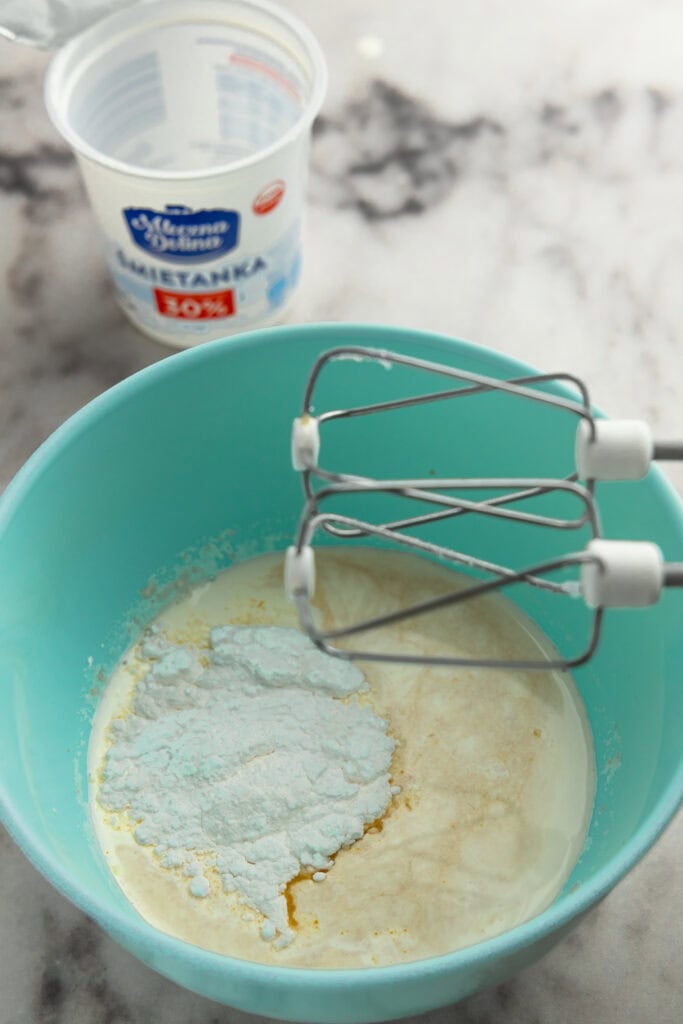
- Whip. Using an electric mixer (stand, handheld, or what have you), beat the ingredients until they reach a thick but still pretty smooth consistency. Use medium or medium-high speed and keep an eye on how the cream is doing. After you start whipping, the volume will quickly double. Then, you’ll go through the soft peaks stage, when you start seeing a trail from the beaters. At that point, you should start paying close attention to the consistency. You typically want to stop at firm peaks when the trail is well-defined and doesn’t disappear, and the peaks hold their shape and don’t droop when you lift the beaters.
 Whip the ingredients until stiff peaks form
Whip the ingredients until stiff peaks form Aim for a consistency that’s close to this
Aim for a consistency that’s close to this
Tips on Making Whipped Cream
- Check As You Go. It’s okay to stop the mixer occasionally to check the cream’s consistency.
- Don’t Overbeat. Watch your cream closely once you reach soft peaks, as it can turn to firm peaks quite quickly. Overbeating past firm peaks will cause the whipped cream to curdle and become grainy. Stop immediately if you see any curdles.
- Stand By Your Mixer. Even with a stand mixer, stay close by to monitor the whipping process. The texture can shift from almost-there to perfect to over-whipped very quickly.
- Stabilize if Needed. Typically, whipped cream maintains its shape and doesn’t weep for about a day or so, and it isn’t great at supporting weight. You can address these issues by stabilizing your whipped cream. If you don’t want anything to do with gelatin, you can go use mascarpone cheese and make mascarpone whipped cream instead.
With these tips in mind, let’s move on to stabilizing whipped cream.
How to Stabilize Whipped Cream
There are several ways to stabilize whipped cream, but some methods are more effective than others.
If you’ve searched online, you’ve probably noticed that two options are more popular than others: gelatin and instant pudding.
Instant pudding is theoretically simpler to use, but it’s not always readily available and may not be ideal for all purposes.
Gelatin, while a bit more challenging to handle, is excellent not only for stabilizing whipped cream but also for creams like Bavarian cream or diplomat cream. Learning the basics of working with gelatin sets you up for success in other applications.
Stabilizing Using Gelatin

Here’s how I stabilize whipped cream with gelatin. It’s a slightly different process than most recipes recommend, but it helps prevent the gelatin from curdling before incorporating it with the whipped cream.
You’ll need 1 teaspoon of gelatin per one cup of heavy cream.
Here are the steps:
- Bloom gelatin. About 10 minutes before you plan to whip the cream, mix powdered gelatin with cold water in a small bowl. You’ll need three times the volume of water to gelatin, or five times the weight of water to gelatin. A simple conversion is using a tablespoon of water for every teaspoon of gelatin.
 Combine gelatin
Combine gelatin with water and allow the mixture
with water and allow the mixture to sit for 10 minutes
to sit for 10 minutes
- Melt gelatin. Warm the gelatin in the microwave, using short bursts and stirring in between, or over a hot water bath.
- Temper. Mix 1 to 2 tablespoons of cold heavy cream into the melted gelatin, stirring thoroughly. If the gelatin begins to set too quickly because it cools down, reheat it slightly to keep the mixture liquid and curd-free. I typically keep the gelatin warm in a hot water bath while incorporating the cold cream to prevent it from setting.
 Mix in 2 tbsp cold cream into melted gelatin
Mix in 2 tbsp cold cream into melted gelatin Use double boiler to prevent setting
Use double boiler to prevent setting Heat gently until smooth and lump-free
Heat gently until smooth and lump-free
- Whip cream to soft peaks. Pour cold heavy cream into a bowl, add vanilla extract and powdered sugar, then whip to soft peaks. The mixture should double in volume, and the whisks should start leaving a trail behind them.
- Add gelatin. Once the gelatin is liquid and the whipped cream has doubled in volume, slowly pour the mixture into the cream while whipping.
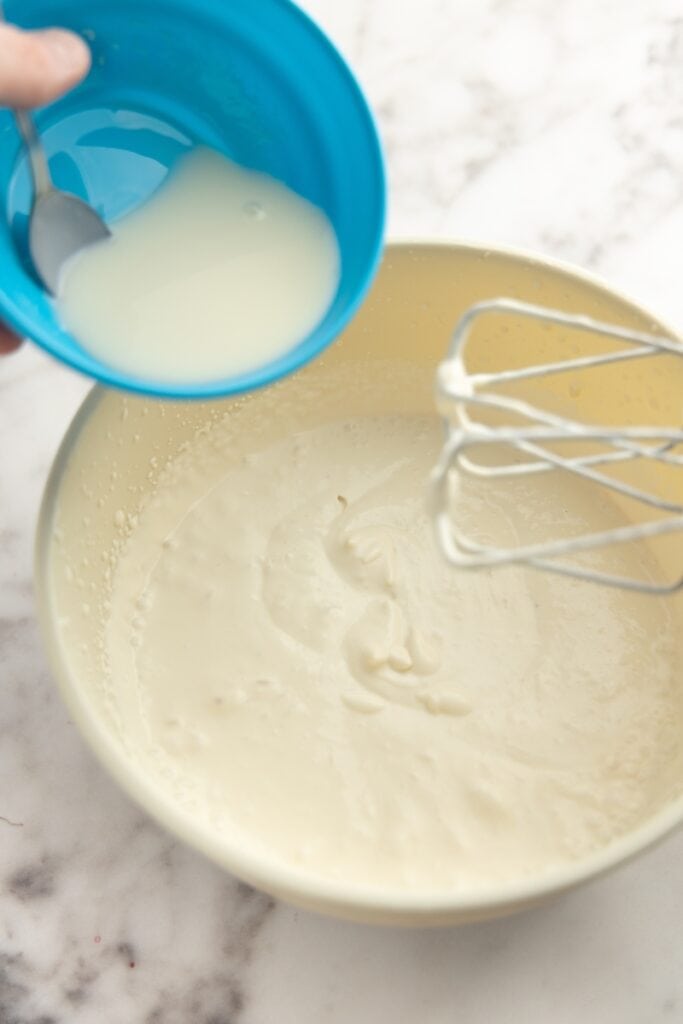
- Whip to firm(-ish) peaks. Continue whipping the cream with the gelatin to reach firm peaks. Sometimes, the cream might not achieve firm peaks due to the added water from the gelatin. In such cases, aim for a slightly softer peak that will firm up once it sets.
Flavor Variations
Plain whipped cream is a classic, but why not mix it up with some exciting flavors? Here are a couple of ideas:
- Coffee. Heat up a bit of heavy cream, use it to dissolve instant coffee, then cool down and stir in with the remaining cold heavy cream before whipping. You’ll need a teaspoon of instant coffee and two teaspoons of heavy cream for one cup of heavy cream you want to make.
- Almond extract. Substitute vanilla extra with almond extract for a nutty kick.
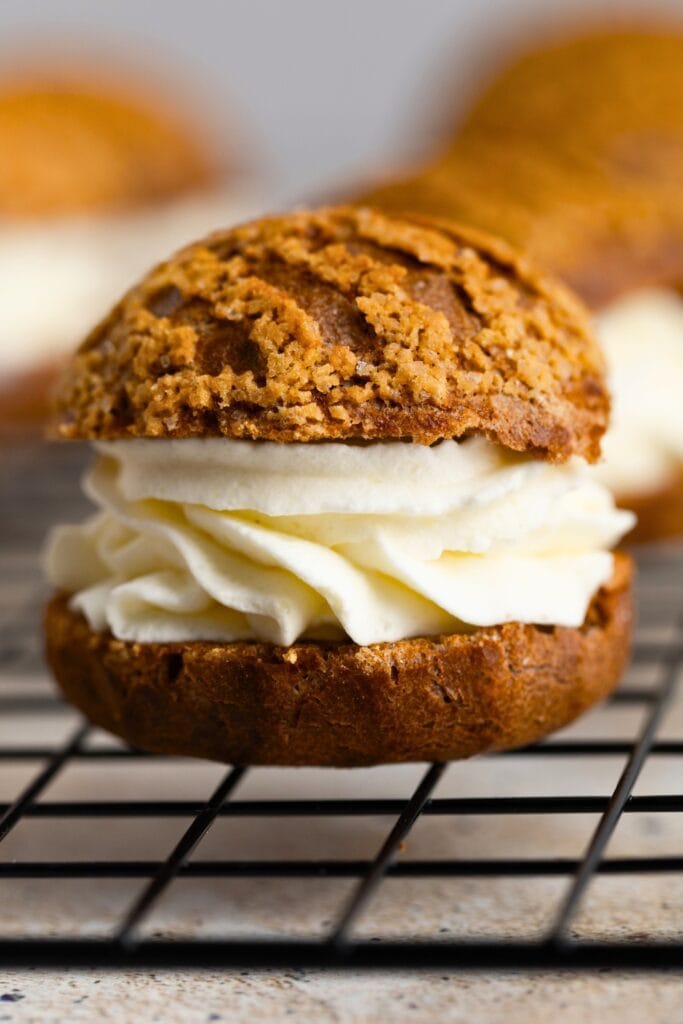
Infusions
Infusing heavy cream is a fantastic way to add depth to your whipped cream. The difference between adding flavor directly (as mentioned above) and infusing the whipped cream is that you need time to infuse it, and you need to do that in advance.
Examples:
- Tea infusion. Heat the heavy cream until it’s just about to boil, then remove from heat and add a teaspoon of tea leaves or a tea bag for each cup of cream. Allow it to steep for 20 to 30 minutes, then strain and chill in the fridge for at least 4 to 6 hours before whipping. This method was perfect when I made my Earl Grey cream puffs.
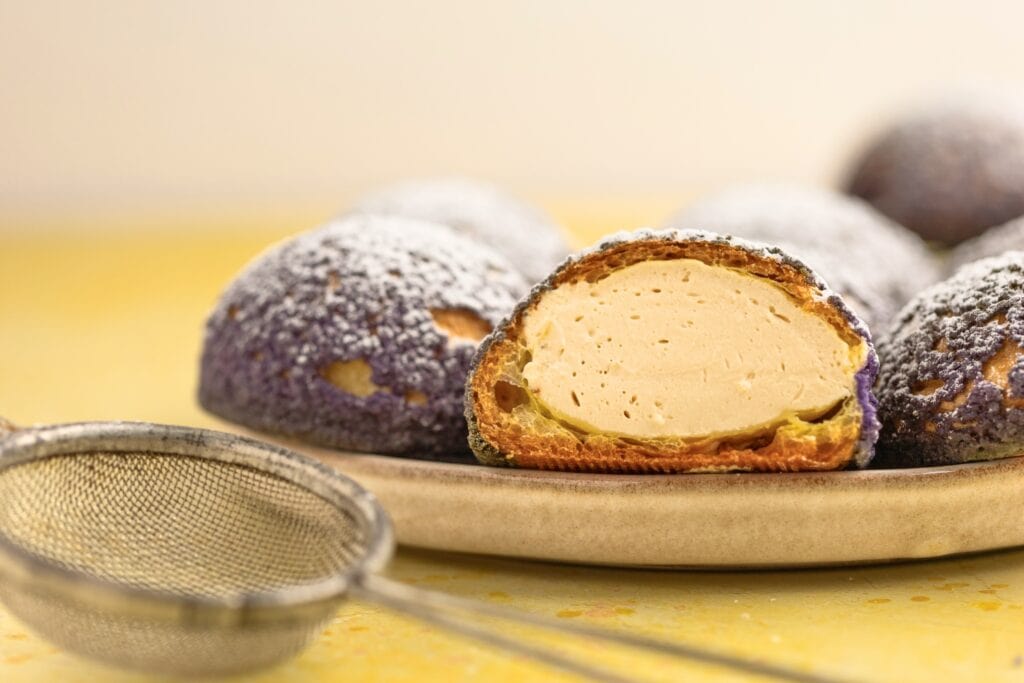
Storage
Plain whipped cream holds shape without weeping for about a day, while stabilized whipped cream keeps its consistency for 3 to 4 days.
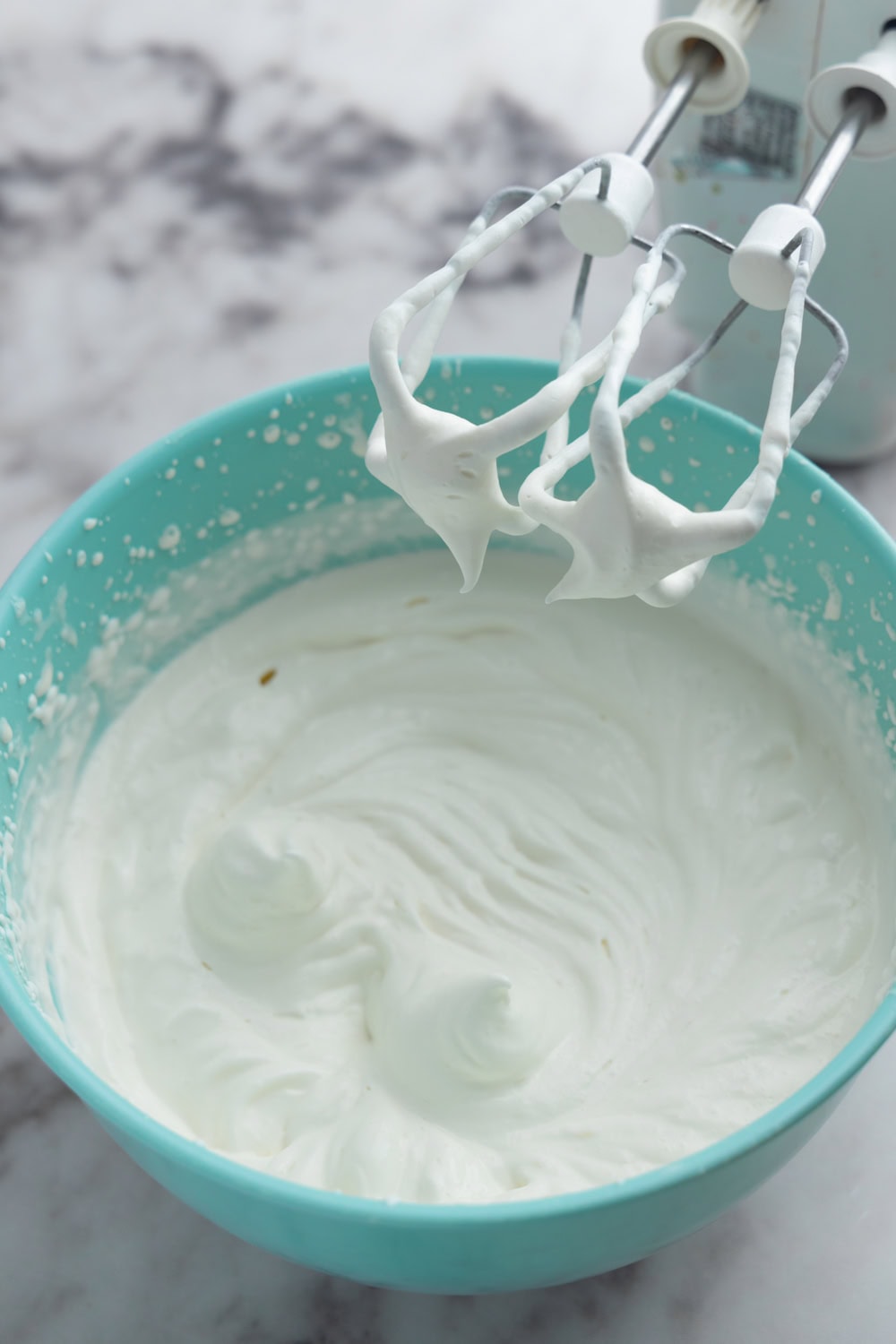
Equipment
Ingredients
- 1 cup heavy cream ~240g
- 1/4 cup powdered sugar ~25g
- 1 teaspoon vanilla extract
- 1 teaspoon gelatin
- 1 tablespoon water cold
Instructions
Plain Whipped Cream
- Prepare Ingredients: In a chilled bowl, combine cold heavy cream, powdered sugar, and vanilla extract.1 cup heavy cream, 1/4 cup powdered sugar, 1 teaspoon vanilla extract
- Whip: Whip the mixture with an electric mixer on medium to medium-high speed. Monitor progress closely after the cream volume doubles. Stop at the firm peaks stage, where the beaters leave a clear trail and peaks stand up without collapsing.
Stabilized Whipped Cream (Gelatin)
- Bloom Gelatin: Mix powdered gelatin with cold water in a small bowl. Use 1 tablespoon of water for every teaspoon of gelatin. Let it sit for about 10 minutes to bloom.1 teaspoon gelatin, 1 tablespoon water
- Temper Gelatin: Stir 1 to 2 tablespoons of cold heavy cream into the melted gelatin until smooth. If the mixture starts to set too quickly, gently reheat it in a double boiler to keep it liquid.
- Whip Cream to Soft Peaks: Whip the heavy cream with powdered sugar and vanilla extract until it doubles in volume and the whisks start leaving a trail behind them.1 cup heavy cream, 1 teaspoon vanilla extract, 1/4 cup powdered sugar
- Add Gelatin Mixture: When the whipped cream has doubled in volume, slowly pour the gelatin mixture into the cream while continuing to whip.
- Whip to Stiff Peaks: Whip the cream until it forms firm peaks. If the cream doesn't reach firm peaks due to the added water, aim for slightly softer peaks—they will firm up as the mixture sets. Stop whippeing immediately if it starts to curdle.

